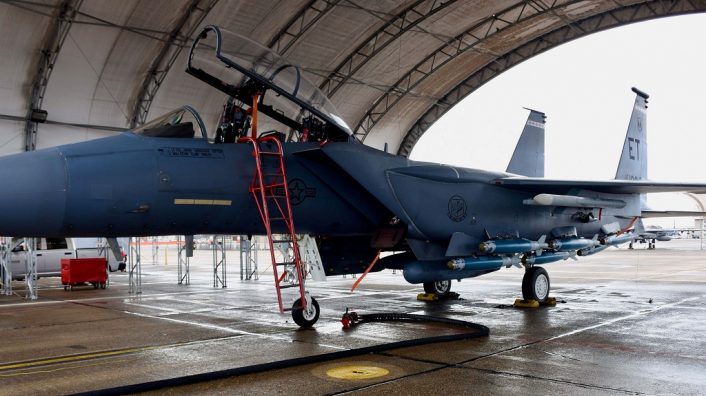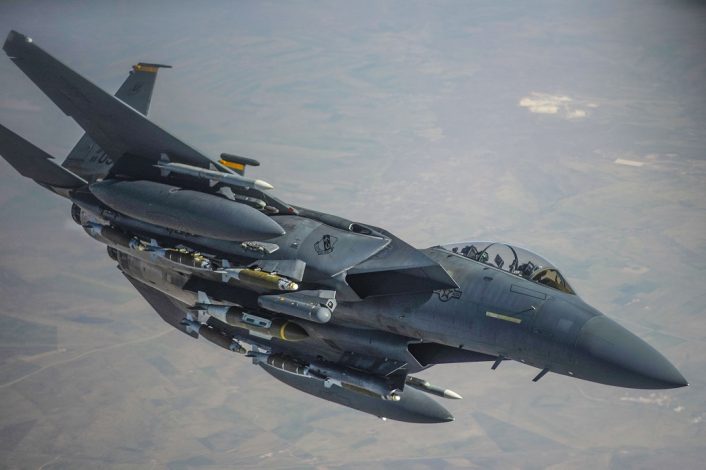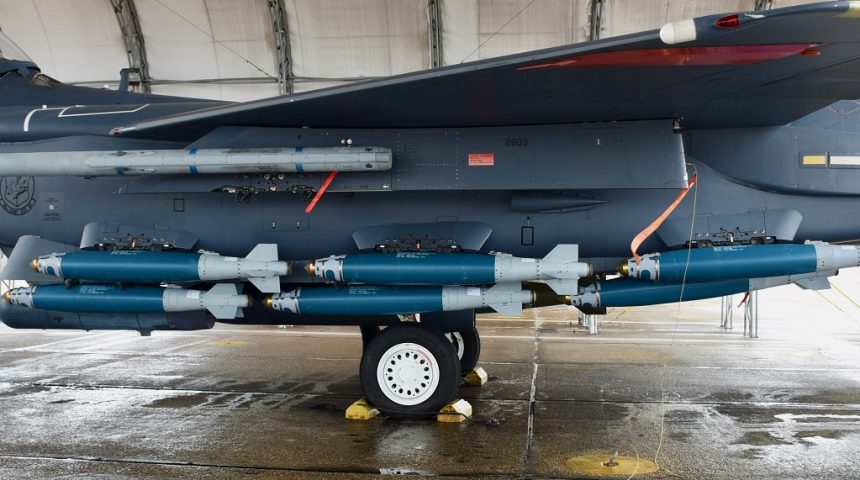This heavy configuration would allow fully assembled JDAMs to be transported at a remote location to rearm the F-15E and other aircraft as part of the Agile Combat Employment model.
The U.S. Air Force published an interesting photo of a recent test performed by the 85th Test and Evaluation Squadron, showing an F-15E Strike Eagle (on loan from the 40th Flight Test Squadron, the same which will receive the first F-15EX) about to fly with six inert GBU-38 JDAMs on a single side of the aircraft on Feb 22, 2021. The shape of a bigger GBU-31 can be seen on the other side of the aircraft.
This test is a proof of concept for Agile Combat Employment (ACE) which aims to increase the carrying capacity of the Strike Eagle so it can act as a “bomb truck” and move fully assembled bombs that can be used at remote location to rearm the F-15E itself or other aircraft.
“Currently the F-15E is authorized to carry a max of nine JDAMs, but the success of this test expands that to 15 JDAMs,” said Maj. Andrew Swanson, F-15E Weapons System Officer, 85th TES. Until now, the F-15E was cleared to carry only three JDAMS under the three lower hardpoints of each “Fast Pack”, plus one under the centerline and other two replacing the external fuel tanks. After these tests, the Strike Eagle will be authorized to carry JDAMs also on the upper three hardpoints of the “Fast Packs”.
“The Strike Eagle can now carry enough JDAMs for an active combat mission, land at a remote location, and reload itself and/or another aircraft – such as an F-35 or F-22 – for additional combat sorties,” said Lt. Col. Jacob Lindaman, commander, 85th TES. The USAF press release noted that not all the JDAMs carried can be employed in a single mission, so it is possible that the six bombs mounted on the upper hardpoints of the “Fast Packs” may not be cleared for release in combat, restricting the F-15E to release them only from the lower hardpoints.

According to the U.S. Air Force, the ACE concept envisions the ability to generate airpower from austere airfields with varying levels of capacity and support in a contested environment, dispersing forces across different or remote airports and support their operations with fewer specialists. The purpose is “to become more agile in our execution, more strategic in our deterrence, and more resilient in our capability. Agility, Deterrence, and Resiliency are essential to defense and operational capability in a contested environment,” the U.S. Air Force in Europe website says when explaining the ACE Concept of Operations.
The USAF noted that reloading an aircraft at a remote location previously took two C-130s to carry the necessary munitions and personnel and required the bombs to be assembled after their delivery, taking extra time that would be considered very precious during high intensity combat operations. With the additional carriage authorized on the F-15E, fully assembled bombs can be transported to the remote airfield, reducing the requirement to just one C-130.
There, the bombs would be moved from the upper hardpoints of the “Fast Packs” to the lower ones or to other aircraft operating from that location, eliminating lengthy onsite bomb assembling and allowing the ground personnel to immediately rearm aircraft as soon as the disembark from the supporting C-130. Also, the smaller F-15E would be less vulnerable than two C-130s while delivering bombs to the airfield in a contested environment.

In the past, the B-52 Stratofortress and P-3 Orion (now replaced by the P-8 Poseidon) were reportedly used to transport bombs to forward locations for other aircraft during ferry flights. The amount of support required for these aircraft would not allow them to be easily used in a similar role during ACE missions.
Seen B-52s used to give bombs a free-ride from the U.S. to the UK, replenish bomb stores with F-15s if they are already making the journey doesn’t seem entirely mad.
— Tony Osborne (@Rotorfocus) March 2, 2021
According to Maj. Swanson, this new tactic originated at an annual Weapons and Tactics Conference and could be employed in theater in as little as one month.









